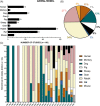Cell sources proposed for nucleus pulposus regeneration
- PMID: 35005441
- PMCID: PMC8717099
- DOI: 10.1002/jsp2.1175
Cell sources proposed for nucleus pulposus regeneration
Abstract
Lower back pain (LBP) occurs in 80% of adults in their lifetime; resulting in LBP being one of the biggest causes of disability worldwide. Chronic LBP has been linked to the degeneration of the intervertebral disc (IVD). The current treatments for chronic back pain only provide alleviation of symptoms through pain relief, tissue removal, or spinal fusion; none of which target regenerating the degenerate IVD. As nucleus pulposus (NP) degeneration is thought to represent a key initiation site of IVD degeneration, cell therapy that specifically targets the restoration of the NP has been reviewed here. A literature search to quantitatively assess all cell types used in NP regeneration was undertaken. With key cell sources: NP cells; annulus fibrosus cells; notochordal cells; chondrocytes; bone marrow mesenchymal stromal cells; adipose-derived stromal cells; and induced pluripotent stem cells extensively analyzed for their regenerative potential of the NP. This review highlights: accessibility; expansion capability in vitro; cell survival in an IVD environment; regenerative potential; and safety for these key potential cell sources. In conclusion, while several potential cell sources have been proposed, iPSC may provide the most promising regenerative potential.
Keywords: biologic therapies; regenerative medicine; stem cell; tissue engineering.
© 2021 The Authors. JOR Spine published by Wiley Periodicals LLC on behalf of Orthopaedic Research Society.
Conflict of interest statement
The authors declare no conflicts of interest.
Figures





Similar articles
-
Intradiscal injection of human recombinant BMP-4 does not reverse intervertebral disc degeneration induced by nuclectomy in sheep.J Orthop Translat. 2022 Sep 23;37:23-36. doi: 10.1016/j.jot.2022.08.006. eCollection 2022 Nov. J Orthop Translat. 2022. PMID: 36196149 Free PMC article.
-
Differentiation of Pluripotent Stem Cells into Nucleus Pulposus Progenitor Cells for Intervertebral Disc Regeneration.Curr Stem Cell Res Ther. 2019;14(1):57-64. doi: 10.2174/1574888X13666180918095121. Curr Stem Cell Res Ther. 2019. PMID: 30227822 Review.
-
An Intervertebral Disc (IVD) Regeneration Model Using Human Nucleus Pulposus Cells (iHNPCs) and Annulus Fibrosus Cells (iHAFCs).Adv Healthc Mater. 2025 Apr;14(10):e2403742. doi: 10.1002/adhm.202403742. Epub 2025 Mar 7. Adv Healthc Mater. 2025. PMID: 40052622 Free PMC article.
-
Glis1 and oxaloacetate in nucleus pulposus stromal cell somatic reprogramming and survival.Front Mol Biosci. 2022 Nov 3;9:1009402. doi: 10.3389/fmolb.2022.1009402. eCollection 2022. Front Mol Biosci. 2022. PMID: 36406265 Free PMC article.
-
Mesenchymal stem cells in regenerative medicine: Focus on articular cartilage and intervertebral disc regeneration.Methods. 2016 Apr 15;99:69-80. doi: 10.1016/j.ymeth.2015.09.015. Epub 2015 Sep 15. Methods. 2016. PMID: 26384579 Review.
Cited by
-
Papain Injection Creates a Nucleotomy-like Cavity for Testing Gels in Intervertebral Discs.Gels. 2024 Sep 2;10(9):571. doi: 10.3390/gels10090571. Gels. 2024. PMID: 39330173 Free PMC article.
-
Importance of Matrix Cues on Intervertebral Disc Development, Degeneration, and Regeneration.Int J Mol Sci. 2022 Jun 21;23(13):6915. doi: 10.3390/ijms23136915. Int J Mol Sci. 2022. PMID: 35805921 Free PMC article. Review.
-
Why clinical trials in disc regeneration strive to achieve completion: Insights from publication status and funding sources.JOR Spine. 2024 May 24;7(2):e1329. doi: 10.1002/jsp2.1329. eCollection 2024 Jun. JOR Spine. 2024. PMID: 38800643 Free PMC article.
-
Explorative Study of Modulatory Effects of Notochordal Cell-Derived Extracellular Vesicles on the IL-1β-Induced Catabolic Cascade in Nucleus Pulposus Cell Pellets and Explants.JOR Spine. 2025 Jan 29;8(1):e70043. doi: 10.1002/jsp2.70043. eCollection 2025 Mar. JOR Spine. 2025. PMID: 39881783 Free PMC article.
-
From hyperglycemia to intervertebral disc damage: exploring diabetic-induced disc degeneration.Front Immunol. 2024 Feb 20;15:1355503. doi: 10.3389/fimmu.2024.1355503. eCollection 2024. Front Immunol. 2024. PMID: 38444852 Free PMC article. Review.
References
Publication types
Grants and funding
LinkOut - more resources
Full Text Sources
Research Materials
Miscellaneous

